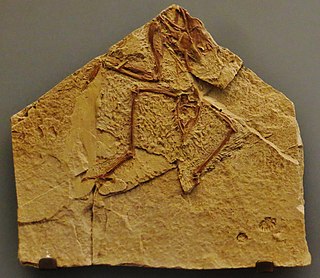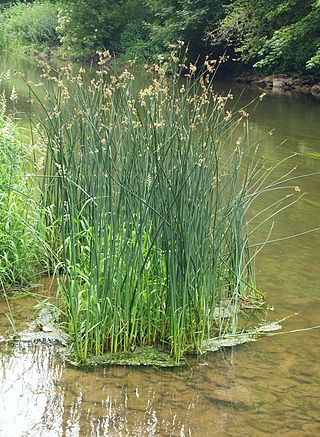
Acanthocephala is a group of parasitic worms known as acanthocephalans, thorny-headed worms, or spiny-headed worms, characterized by the presence of an eversible proboscis, armed with spines, which it uses to pierce and hold the gut wall of its host. Acanthocephalans have complex life cycles, involving at least two hosts, which may include invertebrates, fish, amphibians, birds, and mammals. About 1420 species have been described.

Isoetes lacustris, the lake quillwort or Merlin's grass, is a boreal quillwort native on both sides of the northern Atlantic Ocean. Synonyms include Isoetes hieroglyphica.

Dracunculus medinensis is a nematode that causes dracunculiasis, also known as guinea worm disease. The disease is caused by the female which, at around 80 centimetres in length, is among the longest nematodes infecting humans. In contrast, the longest recorded male Guinea worm is only 4 cm.
Chiayusaurus is a genus of sauropod dinosaur known from teeth found in China and possibly also South Korea. Two species have been named for this obscure genus, though only the type, C. lacustris, is still seen as valid. It was originally named as Chiayüsaurus, but the ICZN does not permit special characters, so the name was corrected to Chiayusaurus. The obsolete name can still be seen in older sources, though. As a sauropod, Chiayusaurus would have been a large, quadrupedal herbivore.

The European perch, also known as the common perch, redfin perch, big-scaled redfin, English perch, Euro perch, Eurasian perch, Eurasian river perch, Hatch, poor man's rockfish or in Anglophone parts of Europe, simply the perch, is a predatory freshwater fish native to Europe and North Asia. It is the type species of the genus Perca.

Iris lacustris, the dwarf lake iris, is a plant species in the genus Iris, subgenus Limniris and in the section Lophiris. It is a rhizomatous, beardless perennial plant, native to the Great Lakes region of eastern North America. It has lavender blue or violet-blue flowers, a very short stem and long fan-like green leaves. It is cultivated as an ornamental plant in temperate regions. It is closely related to Iris cristata.
The Lake Chad gerbil or Lake Chad tateril is a species of rodent found in Cameroon and Nigeria. Its natural habitats are dry savanna, subtropical or tropical dry shrubland, and arable land.

Concornis is a genus of enantiornithean birds which lived during the early Cretaceous period, in the late Barremian age about 125 million years ago. Its remains are known from the Calizas de La Huérgina Formation at Las Hoyas, Cuenca province, Spain. The single known species, Concornis lacustris, was described from the remains of one fairly complete individual skeleton.

Acroloxus lacustris, or the lake limpet, is a small freshwater limpet or snail, a species of aquatic gastropod mollusk in the family Acroloxidae.

Gerris lacustris, commonly known as the common pond skater or common water strider, is a species of water strider, found across Europe.

Amarinus lacustris is a species of freshwater crab from Australia, New Zealand and nearby islands, where it lives in water of various salinities. It grows up to 10 mm (0.4 in) wide, with an H-shaped groove on its back. It is an omnivore and is eaten by crayfish and fish. It was first discovered in Lake Pupuke, near Auckland, and is the only freshwater crab in New Zealand.

Gammarus lacustris is an aquatic amphipod.

Orthotelia is a genus of moths in the subfamily Orthoteliinae.Orthotelia sparganella, a moth of the family Glyphipterigidae, is its only species.
Delftia lacustris is a Gram-negative, nonfermentative, motile, rod-shaped bacterium from the family Comamonadaceae, which was isolated from mesotrophic lake water in Denmark. It has the ability to degrade peptidoglycan through chitinase and lysozyme activity.

Carex lacustris, known as lake sedge, is a tufted grass-like perennial of the sedge family (Cyperaceae), native to southern Canada and the northern United States. C. lacustris us an herbaceous surface-piercing plant that grows in water up to 50 cm (1.6 ft) deep, and grows 50–150 cm (1.6–4.9 ft) tall. It grows well in marshes and swampy woods of the boreal forest, along river and lake shores, in ditches, marshes, swamps, and other wetland habitat. It grows on muck, sedge peat, wet sand or silt, in filtered or full sunlight.

Schoenoplectus lacustris, the lakeshore bulrush or common club-rush, is a species of club-rush that grows in fresh water across Europe and some neighbouring areas.

Cucullanus elegans is a species of parasitic nematode. It is an endoparasite of the European perch.

Camallanus is a genus of parasitic roundworms in the family Camallanidae.
Panopeus lacustris, the knot-fingered mud crab, is a true crab belonging to the infraorder Brachyura. It can be distinguished from related species by its exceptionally broad and knobbly main chela (claw).
Phytophthora lacustris is an oomycete plant pathogen.














